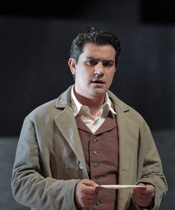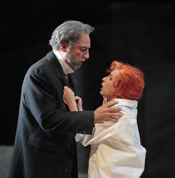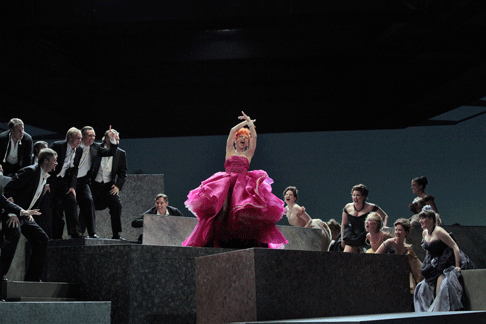 Saimir Pirgu (Alfredo)
Saimir Pirgu (Alfredo)
During the intensely dramatic prelude to Act IV, anonymous stage figures in
half light, darted about draping the tombs with white shrouds preparing the
death scene of Violetta — so much for that essential orchestral moment;
again our attention had fled. For Flora Bervoix’s Act III party, the
weighty boxes, artfully arranged at varying heights, served as pedestals to
show off swaying party girls in lavish 20th century dancing gowns.
“Dancing on her grave?” Santa Fe’s new mounting of
Verdi’s opera, largely the work of a director Laurent Pelly’s
French team and the prima donna Natalie Dessay, seemed an evening at Père
Lachaise, almost literally, but Lachaise-manqué, transmogrified. The conceit
was interesting; many in the audience liked it and enjoyed its innovative
energy, yet it was, as we say, for its own sake — it added no new insight
into the old opera. It could also get in the way.
 Laurent Naouri (Germont) & Natalie Dessay (Violetta)
Laurent Naouri (Germont) & Natalie Dessay (Violetta)
Opinion divides on Mme. Dessay, as it usually will when coloraturas essay
Violetta’s essentially dramatic role. Through history, light-voiced divas
such as Galli-Curci, Lily Pons and Roberta Peters have tried and faded with the
fatal part. Deconstructively ruinous at Santa Fe was Dessay’s Act II
costume — dull, shapeless cotton slacks and a large man’s-style
white overshirt; barefoot. She was a 1960s hippie caught at home. The problem
was it robbed her of much dignity: and Violetta’s self-denying dignity is
key to the effect of this central act, with the two Germont men, each asking
her something different, and opposing. She is cruelly torn; it takes all her
resources to survive intact. By dressing her way down for the big confrontation
scenes, Dessay’s Violetta lost a lot of feminine stature and,
unintentionally I am sure, pushed her comic-seeming side; she looked raffish
and moved in an almost Carol Burnett way — all wrong. Producer Pelly got
this act badly off key. To do anything to defeminize Violetta is a grave
mistake. Violetta must be poignantly believable in Act II — or her show
does not fly, hélas!
The device of the graveyard underlying the whole opera seemed an over-kill,
ultimately a kind of director’s bad joke. Once again, where was dignity,
seriousness? La traviata is a mid-19th century tragic opera, with many
social overtones; it is most certainly to be taken seriously. But I did not
sense a lot of that with M. Pelly, though the performing artists worked hard.
Where was letting the music speak for itself (as in the two preludes mentioned
above)? Is it anything less than an affront to second-guess Giuseppe Verdi in
judging the effect of his music, and what it takes to put it over in theatrical
terms? Opera lovers will have their own views on this. In an interesting touch,
Père Germont was costumed and played as a 19th century figure, and that he
surely is; but Violetta is no less so, and to take her out of that cultural
milieu was counterproductive.
 Natalie Dessay (Violetta)
Natalie Dessay (Violetta)
Finally, Mme. Dessay is not a Violetta. As seen on the Santa Fe
stage, she is a little bird — in Act I a frantic, drunken little bird
with an orange wig and bright red and pink plumage; by the end she was a
plucked pullet flopping about the stage. Her voice does not have the dynamic or
tonal range to explore the full dimensions of Verdi’s music or
Violetta’s emotions; it is almost always the same color. She was wise to
sing both stanzas of “Addio del passato…” for a soft
pianissimo tone is her best asset just now, and she long held the aria’s
final p. high-A. A singular moment. I like Mme. Dessay a lot, and she’s
had a wonderful career, especially considering two throat surgeries and a
baritone husband. I think she has the spunk, but ultimately not enough vocal
resource to do justice to Verdi’s paragon soprano role. The surprise of
the evening was the excellence of Parisian baritone Laurent Naouri in the role
of Père Germont. His well-voiced traditional portrayal played strongly against
the eccentricity of the rest of the production; he showed vividly how this
wonderful opera should be treated. The young Alfredo was debut artist Saimir
Pirgu, an Albanian tenor with a pleasing voice and manner, graced by a nice
smile. In the latter stages of the opera he warmed to some beautiful soft-toned
singing.
J. A. Van Sant ©2009



